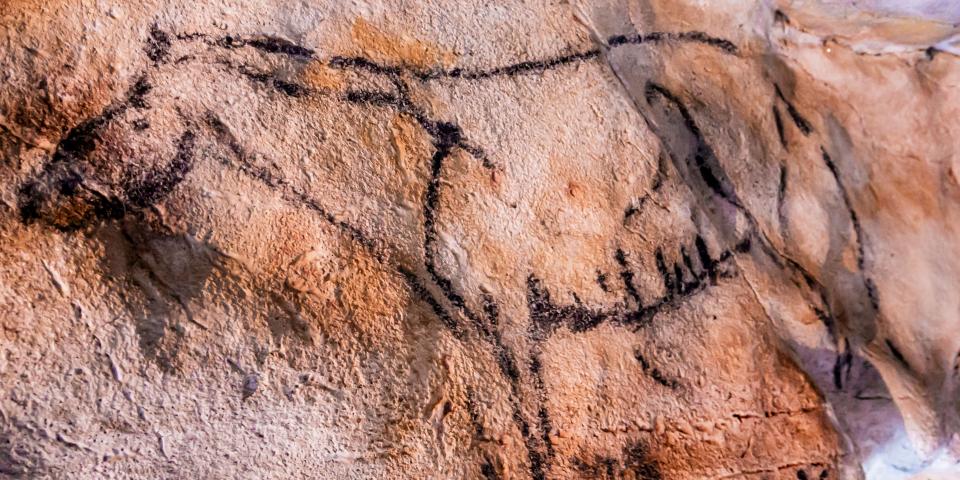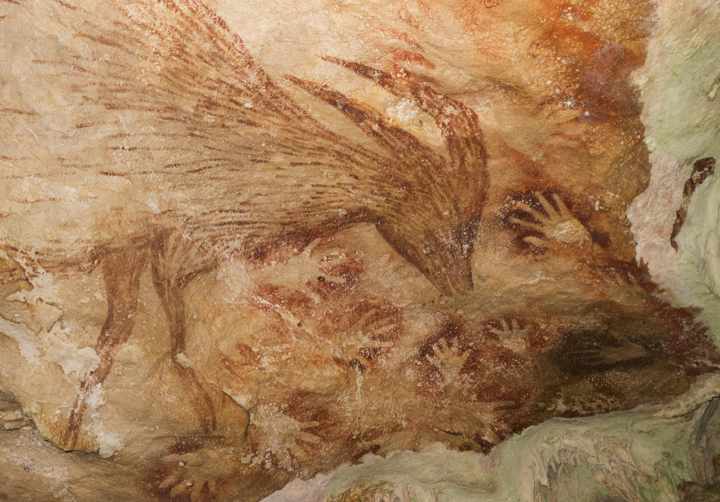 |
| El Castillo in Spain, |
In caves on the Indonesian island of Sulawesi, ancient peoples marked the walls with red and mulberry hand stencils, and painted images of large native mammals or imaginary human-animal creatures.
These are the oldest cave art sites yet known — or at least the oldest attributed to our species. One painting of a Sulawesi warty pig was recently dated as at least 45,500 years old.
Earliest cave paintings
Before the cover was revealed on the Indonesian cave paintings, scholars thought the earliest cave art was in Europe — for example, in the Chauvet Cave in France or El Castillo in Spain, which are 30,000 to 40,000 years old.

|
| These paintings in Chauvet-Pont-d’Arc Cave in France are more than 36,000 years old. |
We now know people were painting inside caves and rockshelters in Indonesia at the same time and even earlier.
Indonesian cave paintings are among the oldest pictorial displays we know on Earth, they occupy a special place among scholars.
Cave paintings in Sulawesi and Borneo are some of the earliest evidence we have that people were living on these islands.
These paintings provide an evidence of the ancient cultural lifestyle, hunting habits and how humans dealt with animals, and they also provide some evidence of early humans’ beliefs and belief in paranormal phenomena.

|
| cave paintings from the indonesian island of sulawesi |
First, a study published in the journal Nature in 2014 found drawings of human hands on the walls of one of these caves, dating back at least 40,000 years.
A study published in 2019 also dated another painting to be 43,900 years old. As this painting depicted characters – half a human and the other half an animal – hunting pigs and dwarf buffaloes, and this painting is considered the oldest witness to the hunting arts in prehistoric times.
The pigments with which these rock art were painted dated the age of the first humans who inhabited Australia to more than 60,000 years, according to what was published by another study in the same journal.
However, these amazing paintings began to lose their splendor since the fifties of the last century, as manifestations of decomposition and disappearance were evident on those distinctive paintings that decorated the walls of these caves for thousands of years, but the reason for this decomposition was unknown.
An alarming reality
Recently, a research study published in Scientific Reports on May 13 sheds light on the mechanisms that lead to the decomposition of these rock art located in 11 sites in the Maros-Pangkep region in South Sulawesi island, Indonesia.
According to the report published by The Conversation, the decomposition of rock art paintings in that region has worsened in recent decades, and is likely to continue at this rate of deterioration with the steady increase in climate change.
To find out the reasons that lead to the rapid deterioration of these drawings – despite their survival for a period of 20 to 40 thousand years – scientists used advanced microscopes and techniques, and finally concluded that the erosion of these drawings resulted from the deposition of salts on the surfaces of the caves.
Salts are deposited on rock surfaces via the water they’re absorbed in. When the water solution evaporates, salt crystals form. The salt crystals then swell and shrink as the environment heats and cools, generating stress in the rock.
In some cases, the result is the stone surface crumbling into a powder. In other instances, salt crystals form columns under the hard outer shell of the old limestone, lifting the art panel and separating it from the rest of the rock, obliterating the art.
On hot days, geological salts can grow to more than three times their initial size. On one panel, for example, a flake half the size of a hand peeled off in under five months.
Global warming increases the temperature of the tropics 3 times, and therefore these areas are experiencing a more severe climate represented by the increase in temperature for several days in a row, as well as the increasing times of drought. Hence, global warming is one of the biggest challenges hindering efforts to preserve the rock art found in the tropics.
Sources:
